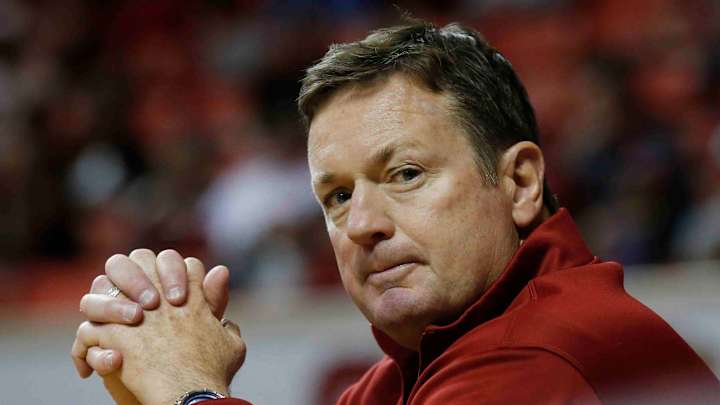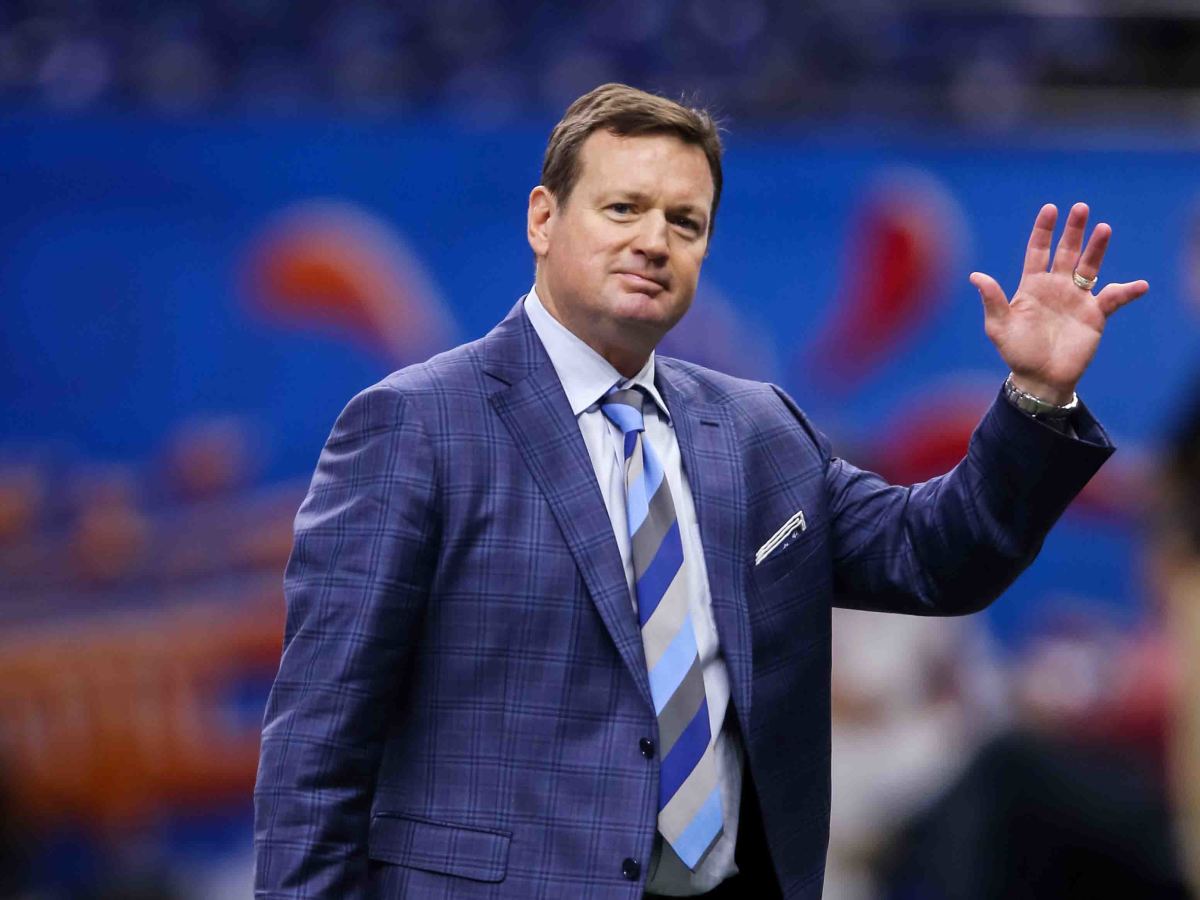Bob Stoops showed early he'd be a solid head coach, and for years he was exactly that

Bob Stoops had yelled at me a few times, but not like this.
“SINCE YOU ARE SOOOO SLOW….”
That rich baritone sounded like it should have come out of a former nose tackle instead of a DB-turned-defensive coordinator who had just turned 36 and looked 10 years younger.
“YOU’RE GOING TO START HERE…”
With this, he urged me out of my three-point stance and into a sprinter’s stance a yard behind the line of scrimmage.
“AND MAYBE YOU’LL GET THERE!”
On this Tuesday in October 1996, Stoops—then in his first season at Florida—wanted one usable look at one of LSU’s favorite sweeps, and the puny walk-on right guard on the scout team had made that impossible. In LSU’s offense, Alan Faneca pulled around the right side and hit the playside linebacker to open a hole for Kevin Faulk. On this particular day, Andy Staples couldn’t get within three yards of Florida linebacker Mike Peterson, and this drove Stoops insane. So he decided to give me a head start in order to get something on film that remotely resembled that LSU play so he could figure out how to best attack it.
Defensive-minded and offensively innovative, Bob Stoops goes out on his own terms
It didn’t bother me that Stoops had called me out in front of everyone. He was correct. I wasn’t doing my job. (Even though that particular job required me to be as fast as a likely future NFL Hall of Famer so I could chase down a guy who would play 14 years in the league.) It also didn’t bother me because Stoops also was the same guy who would come in through the weight room early in the morning and shake everyone’s hand and thank them for working so hard. In the off-season, he would show up at 5:30 a.m. and run county fair drills with the strength coaches and graduate assistants even though a coordinator of his stature could have stayed in bed a little longer. On top of being a brilliant defensive strategist, he showed his players on a daily basis how invested he was. That, in turn, inspired them to work harder for him.
Everyone knew he’d be a head coach, probably a great one. It was only a matter of time. And he was still so young.
He’s still young, relatively speaking. That’s what made it so shocking Wednesday when Stoops announced his retirement after 18 years at Oklahoma. He’s 56, an age when many head coaches are just hitting their stride. Think about it this way: Nick Saban turned 56 during his first season at Alabama. That was four national titles ago. Bobby Bowden didn’t win his first national title until he was 65. Tom Osborne won his first national title at 57. Bob Stoops, whose name belongs in the same breath as the others in this paragraph, hung it up at 56. He’ll be the special assistant to athletic director Joe Castiglione—the guy who hired Stoops in 1999 after five months on the job. Lincoln Riley, the Sooners’ 33-year-old offensive coordinator, will take over as head coach.
Photo from the day Bob Stoops was announced as the head football coach at OU.
— Adam Cooper Kemp (@Adam_WK) June 7, 2017
Castiglione with the sweet stache: pic.twitter.com/g7PgjPJp7b
Five things to know about new Oklahoma head coach Lincoln Riley
“Where did 18 years go?” Stoops asked no one in particular during a press conference Wednesday. It doesn’t feel like it has been that long. We’ll probably learn more details in the coming days and weeks, but this doesn’t seem out of character for Stoops. In the statement Oklahoma released, he said that even though there has been speculation about his health, he hasn’t had any incidents that would keep him from coaching. Here is one guess. Stoops has twin sons, Drake and Isaac. They’ll be senior football players at Norman North High in the fall. Stoops can enjoy their final season without worrying about a game the next day. Daughter Mackie is a student at Oklahoma. His wife Carol recently retired after serving as a regional director for Mary Kay. Money certainly isn’t an issue. Maybe Bob and Carol will buy a giant motorhome and travel the country once they become empty-nesters in less than a year. Maybe they won’t. But they have the option to do whatever they want. And Oklahoma football will roll on under a handpicked replacement who was never named coach-in-waiting but who turned down several head coaching jobs because this handoff seemed like a possibility. “We’ll have a seamless transition,” Stoops said. “And that was important to me.”
The reason this doesn’t seem far-fetched is that Stoops won a national title (2000) and won or shared 10 Big 12 titles with a different business model than most of his counterparts. He lived the sleep-in-the-office lifestyle as an assistant for Bill Snyder at Kansas State, and then he learned in his three years working for Steve Spurrier at Florida that it was possible to win and spend time with your family. When Stoops became the head coach at Oklahoma in ’99, he married the best aspects of Snyder and Spurrier’s philosophies. The meticulous preparation he learned from Snyder meshed with the you-only-live-once attitude he learned from Spurrier. When assistants came from other programs to work for Stoops at Oklahoma and he encouraged them to get out of the office and see their families, their reaction was almost universal. I didn’t know it could be like this.

Because Stoops won so quickly and consistently at Oklahoma, it’s easy to forget where the Sooners were when he arrived in Norman. Oklahoma had gone 5-6 in John Blake’s third season. Barry Switzer had been gone for a decade, and a once-proud program had become quite average. Had Castiglione hired the wrong person, the spiral might have continued. But Castiglione hired the right one, and Stoops assembled an incredible staff. He hired Mike Leach, whose Kentucky offense had given everyone in the SEC fits. “He always kept elements of the offense we installed that first year,” Leach said Wednesday. Leach left after a year, and he was replaced by Mark Mangino, who would go on to take Kansas to an Orange Bowl as a head coach. Later, Stoops would hire Kevin Sumlin as an assistant. Seeing a pattern here? On defense, Stoops initially hired brother Mike to team with Brent Venables, who is the current defensive coordinator at national champion Clemson and might be the first person to figure out how to run a dominant defense opposite an up-tempo offense.
Stoops won big quickly, taking the national title in his second season and earning the nickname “Big Game Bob.” As the years went on, that nickname became more of a pejorative. The Sooners got back to the BCS national title game in the ’03 and ’08 seasons and lost both. But even though Stoops never won another national title, his program remained the best in the Big 12. It dipped occasionally, but few coaches have managed that kind of consistency. Leach believes the trio of Stoops, Castiglione and Oklahoma president David Boren—who all worked at the school for the entirety of Stoops’s tenure—made the program the steadiest in America. “The three of them worked in tandem as a team with a very unique relationship, focus and direction,” Leach said. “That’s what creates great teams. That’s what creates consistency—when everyone is pulling in the same direction.”
Stoops could be loyal to a fault to his assistants. Riley is at Oklahoma now because Stoops kept the offensive coordinator tandem of Jay Norvell and Josh Heupel a year or two longer than the average coach might have. The offense struggled following the departure of Kevin Wilson after the ’10 season, and it didn’t recover until Riley arrived in ’15. By retiring now, Stoops also doesn’t have to deal with any awkwardness if Mike Stoops can’t improve a defense that Oklahoma has won in spite of in several games in the past two seasons.
Oklahoma’s Bob Stoops: Joe Mixon would be dismissed if punch happened now
The most complicated part of Stoops’s legacy will center on the summer of ’14. That’s when he brought in former Missouri receiver Dorial Green-Beckham, who had been kicked off the team in Columbia following a domestic violence accusation. (No charges were filed.) Later that summer, Oklahoma freshman tailback Joe Mixon punched a woman during an argument at a Norman restaurant. Mixon was suspended for a year, but Stoops did not kick him off the team even after viewing video of the incident that was—through an old boy network determined to help out the Sooners—shielded from public view for more than two years even though it was quite obviously a public record because it was the key piece of evidence in a criminal case. Only after the world saw the video did Stoops say that if it happened now, he might have kicked Mixon out of the program.
This was an odd reversal from someone who never seemed to care what anyone else thought about his decisions, but it made sense. Stoops had to do damage control. Those choices in the summer of ’14 had punctured a pristine reputation, and Stoops was getting painted as a win-at-all-costs hypocrite. His moves that summer certainly changed how I felt about Stoops. After that, he was just like all those other coaches who will put up with some awful stuff if it helps them win. This doesn’t preclude Stoops from being an excellent coach, and it won’t keep people in Oklahoma from revering him. Heck, Osborne allowed worse and got elected to Congress and named athletic director at Nebraska. Still, Stoops could have enjoyed an even more exalted place in college football history had he made two better decisions that summer.
Not that Stoops will worry about that. He always concerned himself with how his family, his players and his coaches felt. The outside world could pound sand. He never seemed much like a legacy guy.
That’s probably why he can leave now. Some coaches have an intrinsic need to stack more wins because their identity depends on it. Stoops never seemed that way. He threw his whole self into work when he was there, but it always felt like he could walk away and be just fine.
